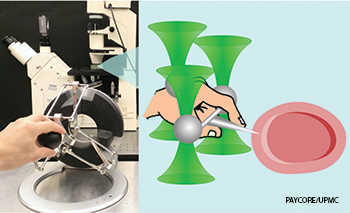
A highly nimble micromanipulation experimental setup. Cells can be explored with advanced laser trapped microtools that extend the operator's sense of touch thanks to a specifically designed haptic teleoperated optical tweezers.
Under a microscope, nanoscale objects and tools can appear close enough for a researcher to touch. When the researcher attempts to manipulate such tiny things, however, it can be difficult to gauge how much force to apply without the ordinary sensory feedback that humans experience in the everyday world.
Adding a so-called “haptic” interface to optical tweezers could guide scientists to give the right amount of force to their microscopic manipulations. The biggest challenge involved in designing such an interface is to magnify the incredibly small forces needed for these manipulations—in the piconewton (pN) range—by a factor of 1012 to reach the range of human perception. Two French researchers recently reviewed the progress toward a practical setup for haptic optical tweezers and proposed improvements for such interfaces (Rev. Sci. Instrum. 84, 081301).
Haptic interfaces, or tactile feedback technologies, already have applications in the macroscale world, from flight simulators to video games. Such systems consist of sensors to detect motion, actuators to create motion and a means of transmitting the sense of motion between the user and objects of interest. According to review authors Cécile Pacoret and Stéphane Régnier of the Université de Pierre et Marie Curie in Paris, a Japanese group first integrated a haptic interface with optical tweezers in 2000, but the microscopic use of haptic technology was limited by the slow frame rates of then-available cameras and other bandwidth-limiting issues.
According to the authors, the deflection of laser beams to move tiny objects has a much faster response time than holding the laser fixed and moving the microscope's platform. Cameras with field-programmable gate arrays (FPGAs) or dynamic vision sensors provide fast data acquisition, although they require greater illumination of the microscope field. Recent experiments have demonstrated holographic optical tweezers incorporating a liquid-crystal spatial light modulator and a fast CMOS camera. Complex image-processing algorithms also improve response and feedback.
